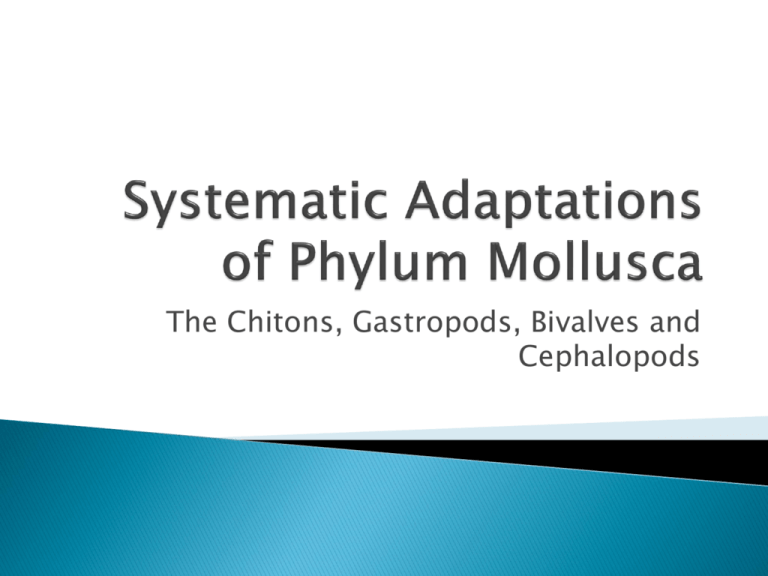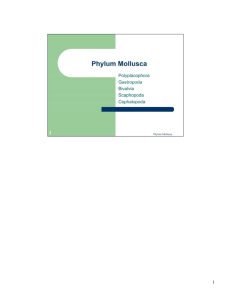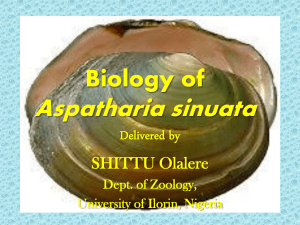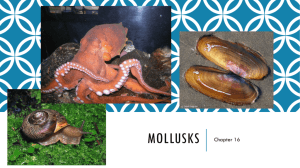Systematic Adaptations of Phylum Platyhelminthes
advertisement

The Chitons, Gastropods, Bivalves and Cephalopods The molluscs are a diverse group of soft bodied invertebrates Some varieties of molluscs produce an external shell (“test” or “valve”)made of calcium carbonate All molluscs have a fold of skin associated with the dorsal body wall called the Mantle which encloses the Mantle Cavity. The mantle cavity houses the gills, if present. Triploblastic (well developed mesoderm) Organ System level of body organization True body cavity (eucoelomate) – the coelom is completely bound by mesodermal tissue and lined with peritoneum. Complete gastrulation – one way digestive tract with a mouth and an anus Protostomes – the first opening of the gastrula forms the mouth Bilateral symmetry Molluscs have a unique body plan with 2 general body regions – the Head-Foot and the Visceral Mass The Head-Foot, as the name implies, contains the primary sense organs characteristic of cephalization, the mouth and feeding apparatus, and locomotor organs The Visceral Mass contains the “guts” – the organs associated with digestion, respiration, reproduction, and circulation Varying degrees of cephalization occur in the molluscs. Some (particularly the cephalopods, which include squid and octopus) have very well developed eyes. Many molluscs (notably the gastropods and cephalopods) have tentacles associated with the Head-Foot region The tentacles are used for “touch” and “taste” https://www.youtube.com/watch?feature=pla yer_detailpage&v=yE0QqxwyL_8 Most molluscs (all gastropods, chitons and cephalopods) have a specialized rasplike feeding organ called a Radula. The radula is a muscular tongue covered with teeth for scraping off food Video of a snail eating Note the antennae, eyes, and mouth Note the texture and movement of the radula http://www.youtube.com/watch?v=cEMK3VN 8pW8 http://www.youtube.com/watch?v=mLVDwlrS q5U The foot portion of the head-foot region is used for locomotion and varies greatly within the phylum Gastropods (“stomach foot”) and Chitons have a broad, laterally flattened ventral foot Pelecypods (“hatchet foot”) have a muscular foot elongated along the dorso-ventral midline Cephalopods (“head foot”) have modified the foot to form a siphon to eject water for propulsion Snails https://www.youtube.com/watch?v=pRmChG 3Jf_Q https://www.youtube.com/watch?v=utxH9M H4tOI Sea Slugs https://www.youtube.com/watch?NR=1&v=E wpexfYnlDE https://www.youtube.com/watch?v=9VL_p2A 7DPg Octopus https://www.youtube.com/watch?v=rOvhs5icTfg https://www.youtube.com/watch?v=tLTWFnGmeg&feature=player_detailpage Squid https://www.youtube.com/watch?v=Nf2iRRWH5O I https://www.youtube.com/watch?v=EeaMOOnm HAA https://www.youtube.com/watch?v=5oOMa53F1s The Visceral Mass contains what we normally think of as the “internal organs” Aquatic forms have Gills for respiration Gills are enclosed in the Mantle Cavity, and covered by the Mantle. All molluscs have a mantle and mantle cavity Some terrestrial forms have diminished gills, and perform gas exchange across the moist membranes of the mantle cavity Many molluscs secrete protein and calcium carbonate from the mantle to create a shell The shell typically has 3 layers: ◦ The periostacum is the outer layer, made of protein secreted by the edge of the mantle ◦ The prismatic layer is the middle layer, made of densely packed prisms of calcium carbonate in a protein matrix ◦ The nacreous layer is secreted continuously by the surface of the mantle. This layer is what we call Mother of Pearl The mechanism of blood circulation varies Bivalves have an Open Circulatory System. Blood pumped by the heart circulates through blood vessels in the gills, but empties into the coelom where the visceral organs are bathed by blood Cephalopods have a Closed Circulatory System. Blood is circulated through blood vessels, including capillaries, into all body regions Metabolic wastes and excess water are removed by the kidneys (metanephridia) The kidneys open on the inside to the coelom, communicating with the blood, and discharge wastes into the mantle cavity The ducts of the excretory system are shared by the Reproductive system, providing passageways for sperm and egg to the mantle cavity The larval form of a mollusc is called a See diagrams and descriptions p. 330 in your textbook Trochophore Mollusca is one of the most diverse and widespread phyla in the animal kingdom, second only to the arthropods We will focus on only a few of the major classes of molluscs ◦ Polyplacophora (Chitons) ◦ Gastropods (snails and slugs) ◦ Pelecypods (Bivalves – Clams, Oysters, Mussels & Scallops) ◦ Cephalopods (Squid, Nautilus and Octopus) Chitons are similar to gastropods in general body form, but lack the degree of cephalization that is characteristic of slugs and snails Chitons are flattened in shape, with multiple prominent gills between the mantle and the foot As the name polyplacophora suggests, the shell consists of many plates Foot is flattened and tight to the belly (thus “gastro” “pod” – belly foot) Definite cephalization with both eyes and tentacles (for tactile sense and chemoreception) Slugs – no shell. Snails – single shell Asymmetrical deposition of calcium carbonate by the mantle causes the shell of snails to coil (see page 335 in text) See page 334 in the textbook During embryonic development, the mantle cavity of gastropods undergoes torsion – the mantle twists so that the posterior of the mantle is relocated over the anterior of the head-foot Torsion allows the snail to more readily retract the head into the shell for protection Torsion also positions the excretory openings over the gills. This problem is resolved by bringing water into the mantle cavity from the left and expelling waste water from the right Due to shell coiling, most snails have the right gill diminished or absent. The whorls of the coiled shell compress the right side of the mantle cavity and visceral mass Terrestrial forms of both snails and slugs are lacking gills entirely, using the moist skin of the mantle cavity for gas exchange. These forms are called Pulmonates Nudibranchs are slugs with exposed gills (nudi = naked, branch = gill) Pelecy = hatchet. The pelecypods are molluscs with a hatched shaped foot Pelecypods are bivalves (2 shells). The shell has 2 distinct parts, attached by a hinge ligament Clams, oysters, and mussels are all pelecypods All are filter feeders and lack a radula All have little or no cephalization (although some have eyes at the rim of the mantle) Many bivalves use their hatchet shaped foot to burrow into the soil The mantle is organized to form an incurrent siphon and an excurrent siphon – which may extend significantly out of the shell Water circulates through the mantle cavity, and ciliary action of the gill surface channels particles of food trapped in the gill mucus to the mouth See textbook pages 340-342 Bivalve shells have a distinct Umbo, the oldest part – representing the position of the embryonic shell The two valves of the shell are connected by a protein hinge ligament. The elasticity of the hinge ligament causes the shell to open A pair of adductor muscles (one anterior and one posterior) contract to close the shell Sand particles trapped between the shell and the mantle may be covered with secretions of calcium carbonate, forming a pearl True Facts about the Land Snail ◦ https://www.youtube.com/watch?v=VTV23B5gBsQ True Facts about the Cuttlefish ◦ https://www.youtube.com/watch?v=GDwOi7HpHtQ True Facts about the Octopus ◦ https://www.youtube.com/watch?v=st8-EY71K84 https://www. fossilera.com /fossils-forsale/ammoni te-pendants







